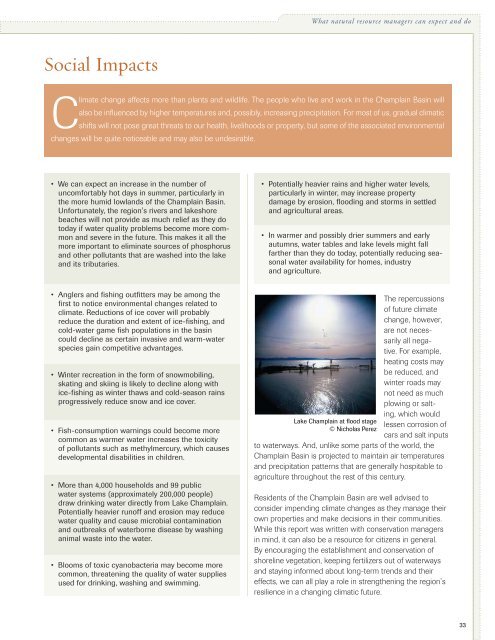Climate Change in the Champlain Basin - The Nature Conservancy
Climate Change in the Champlain Basin - The Nature Conservancy
Climate Change in the Champlain Basin - The Nature Conservancy
You also want an ePaper? Increase the reach of your titles
YUMPU automatically turns print PDFs into web optimized ePapers that Google loves.
What natural resource managers can expect and doSocial Impacts<strong>Climate</strong> change affects more than plants and wildlife. <strong>The</strong> people who live and work <strong>in</strong> <strong>the</strong> Champla<strong>in</strong> Bas<strong>in</strong> willalso be <strong>in</strong>fluenced by higher temperatures and, possibly, <strong>in</strong>creas<strong>in</strong>g precipitation. For most of us, gradual climaticshifts will not pose great threats to our health, livelihoods or property, but some of <strong>the</strong> associated environmentalchanges will be quite noticeable and may also be undesirable.• We can expect an <strong>in</strong>crease <strong>in</strong> <strong>the</strong> number ofuncomfortably hot days <strong>in</strong> summer, particularly <strong>in</strong><strong>the</strong> more humid lowlands of <strong>the</strong> Champla<strong>in</strong> Bas<strong>in</strong>.Unfortunately, <strong>the</strong> region's rivers and lakeshorebeaches will not provide as much relief as <strong>the</strong>y dotoday if water quality problems become more commonand severe <strong>in</strong> <strong>the</strong> future. This makes it all <strong>the</strong>more important to elim<strong>in</strong>ate sources of phosphorusand o<strong>the</strong>r pollutants that are washed <strong>in</strong>to <strong>the</strong> lakeand its tributaries.• Potentially heavier ra<strong>in</strong>s and higher water levels,particularly <strong>in</strong> w<strong>in</strong>ter, may <strong>in</strong>crease propertydamage by erosion, flood<strong>in</strong>g and storms <strong>in</strong> settledand agricultural areas.• In warmer and possibly drier summers and earlyautumns, water tables and lake levels might fallfar<strong>the</strong>r than <strong>the</strong>y do today, potentially reduc<strong>in</strong>g seasonalwater availability for homes, <strong>in</strong>dustryand agriculture.• Anglers and fish<strong>in</strong>g outfitters may be among <strong>the</strong>first to notice environmental changes related toclimate. Reductions of ice cover will probablyreduce <strong>the</strong> duration and extent of ice-fish<strong>in</strong>g, andcold-water game fish populations <strong>in</strong> <strong>the</strong> bas<strong>in</strong>could decl<strong>in</strong>e as certa<strong>in</strong> <strong>in</strong>vasive and warm-waterspecies ga<strong>in</strong> competitive advantages.• W<strong>in</strong>ter recreation <strong>in</strong> <strong>the</strong> form of snowmobil<strong>in</strong>g,skat<strong>in</strong>g and ski<strong>in</strong>g is likely to decl<strong>in</strong>e along withice-fish<strong>in</strong>g as w<strong>in</strong>ter thaws and cold-season ra<strong>in</strong>sprogressively reduce snow and ice cover.• Fish-consumption warn<strong>in</strong>gs could become morecommon as warmer water <strong>in</strong>creases <strong>the</strong> toxicityof pollutants such as methylmercury, which causesdevelopmental disabilities <strong>in</strong> children.• More than 4,000 households and 99 publicwater systems (approximately 200,000 people)draw dr<strong>in</strong>k<strong>in</strong>g water directly from Lake Champla<strong>in</strong>.Potentially heavier runoff and erosion may reducewater quality and cause microbial contam<strong>in</strong>ationand outbreaks of waterborne disease by wash<strong>in</strong>ganimal waste <strong>in</strong>to <strong>the</strong> water.• Blooms of toxic cyanobacteria may become morecommon, threaten<strong>in</strong>g <strong>the</strong> quality of water suppliesused for dr<strong>in</strong>k<strong>in</strong>g, wash<strong>in</strong>g and swimm<strong>in</strong>g.Lake Champla<strong>in</strong> at flood stage© Nicholas Perez<strong>The</strong> repercussionsof future climatechange, however,are not necessarilyall negative.For example,heat<strong>in</strong>g costs maybe reduced, andw<strong>in</strong>ter roads maynot need as muchplow<strong>in</strong>g or salt<strong>in</strong>g,which wouldlessen corrosion ofcars and salt <strong>in</strong>putsto waterways. And, unlike some parts of <strong>the</strong> world, <strong>the</strong>Champla<strong>in</strong> Bas<strong>in</strong> is projected to ma<strong>in</strong>ta<strong>in</strong> air temperaturesand precipitation patterns that are generally hospitable toagriculture throughout <strong>the</strong> rest of this century.Residents of <strong>the</strong> Champla<strong>in</strong> Bas<strong>in</strong> are well advised toconsider impend<strong>in</strong>g climate changes as <strong>the</strong>y manage <strong>the</strong>irown properties and make decisions <strong>in</strong> <strong>the</strong>ir communities.While this report was written with conservation managers<strong>in</strong> m<strong>in</strong>d, it can also be a resource for citizens <strong>in</strong> general.By encourag<strong>in</strong>g <strong>the</strong> establishment and conservation ofshorel<strong>in</strong>e vegetation, keep<strong>in</strong>g fertilizers out of waterwaysand stay<strong>in</strong>g <strong>in</strong>formed about long-term trends and <strong>the</strong>ireffects, we can all play a role <strong>in</strong> streng<strong>the</strong>n<strong>in</strong>g <strong>the</strong> region’sresilience <strong>in</strong> a chang<strong>in</strong>g climatic future.33
















